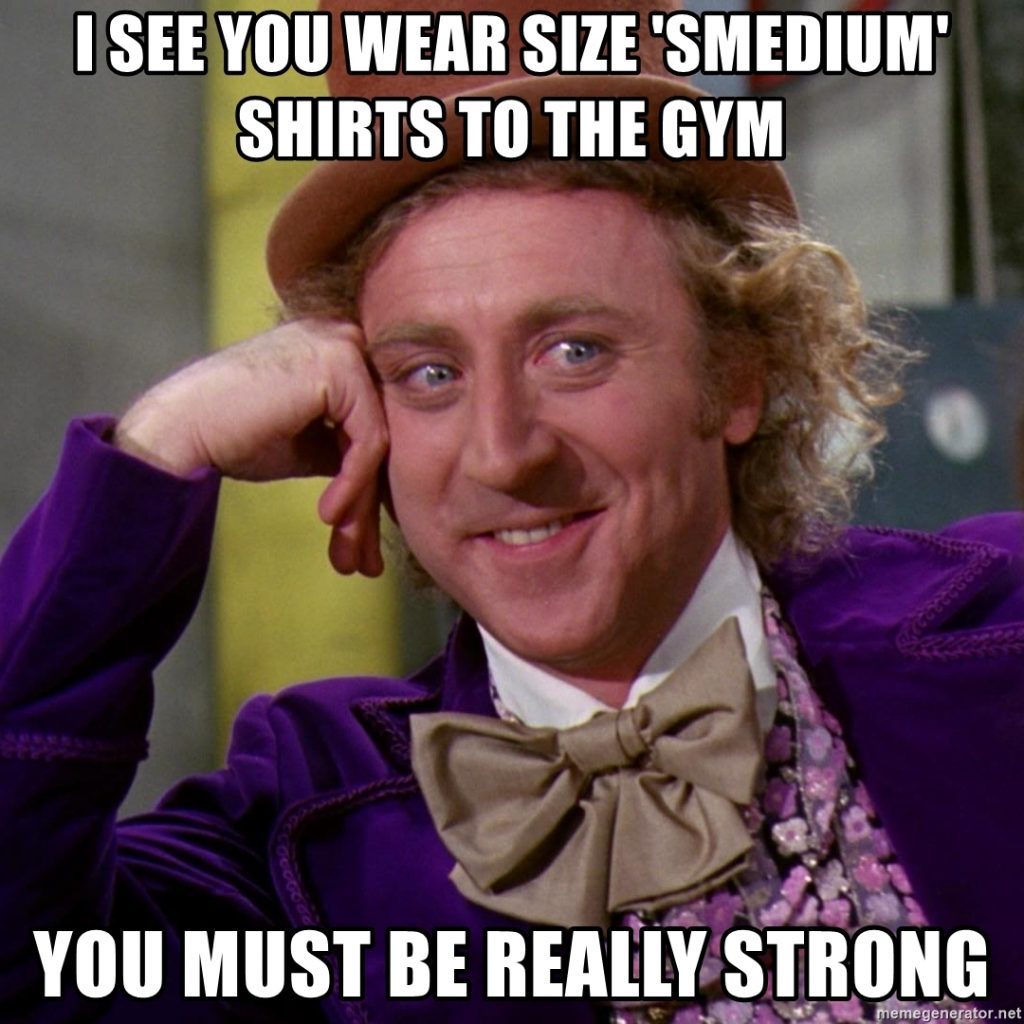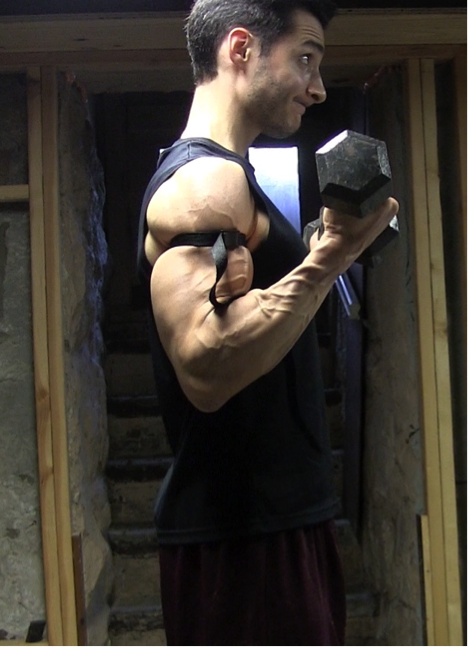As this post goes live Lisa and I are en route to Australia. I’d like to sit here and say I’m doing something productive with 20 hours on a plane like reading a book, catching up on some writing, or, I don’t know, looking lovingly into my wife’s eyes.
But in reality I’m probably watching John Wick or something.
Anyway, I didn’t forget about everyone and I do have a bunch of great content prepared for while I’m away. Today’s pinch writer is Baltimore, MD based trainer, Tim Hendren.
Let’s get jacked.

Blood Flow Restriction Training: The Holy Grail of Gimmicks?
The fitness world is usually full of shit.
What seems like every 30 seconds, a new product pops up in gyms or online that’s hailed as the next cutting-edge tool to take your training to the next level. From the thigh master to waist trainers to oxygen deprivation masks, bullshit peddlers have been taking advantage of the insecurities of fitness enthusiasts for decades.
Tell someone that it takes ten years of consistency with training and nutrition to achieve their desired results and you will struggle in the fitness space. Tell someone to strap a belt around their waist and magically lose 10 lbs. for three easy payments of 12.99 and you’re a millionaire.
Unfortunately, that’s where we’re at.
I’m skeptical at this point when I see something gimmicky.
My stance is guilty before proven innocent for almost everything that doesn’t involve getting stronger using basic core lifts and eating the right amounts of the right foods for your goals.
When I saw blood flow restriction (BFR) for the first time, my brain immediately filed it in the category of useless shake weight’esque type nonsense.
Then I gave it a shot after I saw some trusted coaches (John Meadows, Ben Pakulski, and others) advocating it.
Ok, maybe there’s something to this.
I gave it a shot and the massive pump it provided my arms was undeniable.
Keeping blood trapped in the targeted muscle and reaching failure with an absurdly light weight had to have some legit benefits.
It was time to dig deeper.
What is BFR?
BFR refers to a training strategy that employs the use of cuffs, wraps, bands, or a BFR device placed strategically on the extremities to occlude venous blood flow away from the muscle while maintaining arterial flow into the muscle during an exercise.
In other words, blood goes into the muscle when it’s contracting and gets stuck there while you’re wrapped up.
When done properly and to failure, BFR is quite painful. Want to see someone humbled? Take the baddest dude at the gym, put him through a BFR exercise and watch him writhe in pain and hit failure with 20-35% of his 1 rep max.
To put that in perspective, that’s failing with a 60 lbs. squat when you max 315.
The duration of the exercise and total time with wraps on is under 4 minutes, light speed in terms of reaching muscular failure using a weight you typically warm up with.
What Does the Research Say?
This is all fine and dandy but who cares about the pump (I’m that guy with his hand raised) if it’s not producing any lasting results? When you take a closer look though, it turns out BFR isn’t just a tool for a bro to get a massive arm swell before he puts on his smedium t-shirt and hits the club.

In a recent meta-analysis of almost 50 studies (Lixandrão 2018) comparing traditional heavy load training and training using low loads with BFR, it was a wash with regards to muscle hypertrophy.
Think about that.
Almost 50 studies and the differences between traditional heavy training and light lifting with BFR were statistically insignificant when looking at muscle growth.
I guess this isn’t in the shake weight category after all.
It must be stated that in the same meta-analysis, it was determined that differences in strength were in favor of the heavy load groups by a wide margin.
Training for specificity still reigns supreme, especially regarding maximal strength.
In another study (Takarada Y 2000), patients fresh from ACL surgery were observed.
One group was given traditionally loaded exercises for the quadriceps and another group were given low load exercises combined with BFR. The group using BFR showed markedly less atrophy in the quadriceps when compared with the traditional group and certainly what is typically seen in patients after an ACL repair.
Another win for BFR as a prehab/rehab tool!
Practical Uses
When programming BFR into your training sessions, it’s important to keep in mind that its efficacy is limited to the biceps, triceps, quads, hamstrings, and calves due to the location of the occlusion sites. Sorry folks, it doesn’t matter where you put those wraps, you aren’t occluding your glutes or pecs.
Another limitation is its reluctancy to produce strength gains.
Based on the available research, while BFR hasn’t shown to increase maximal strength anywhere close to traditional lifting, it could be an effective way to maintain strength when dealing with an injury or joint issue that inhibits the trainee from lifting with heavy weight.
Other Scenarios Where BFR is Useful
1. Golfer’s or Tennis Elbow
The dreaded medial or lateral epicondylitis has provided quite a roadblock for arm gains.
There is nothing quite like attempting an overhead triceps extension with an inflamed elbow and the searing pain that follows. One of the more effective strategies I’ve found personally and with clients is taking the weight down, applying the cuffs, and pumping away pain free.
Typically, under these conditions, if the weight is light enough, you can get away with performing the exercise.
Add in the pillow-like effect of blood pooling around the joint due to BFR, and you’ve created an anabolic environment for the muscle minus the pain and risk for more inflammation.
2. Knee Issues
Whether it’s arthritis or simply cranky knees from heavy compound lifts, BFR can be a great way to hammer the quads and hamstrings without placing more stress on the knees. The same concept from #1, your inflamed knees will appreciate the low loads and allow the targeted muscles to reach failure without pain in a full range of motion.
3. Added Frequency
When working with heavier weights in a strength phase, it may be helpful to limit the load of isolation work for arms and legs. Training with BFR can provide an intense stimulus to the targeted muscles without anywhere close to the amount of muscle damage or joint stress from high loads. Furthermore, if you are using low loads and BFR, you can do the isolation lifts more frequently without sacrificing performance in the heavy lifts.
4. In-Home or On-the-Road
If you are training at home or in a hotel gym working with weights that resemble “My First Weight Set” by Fisher-Price, BFR can be a great way to jack up the intensity and train closer to failure regardless of load.
We’ve all been burned by bullshit online hotel gym pictures. You book the room thinking it’s an acceptable gym then show up to lift and they don’t have any dumbbells over 25 lbs. Infuriating.
Pack your wraps or cuffs just in case.
5. Prehab or Rehab
As stated earlier, the resulting atrophy from an injury or operation can be mitigated with low loads and BFR.
6. During a Deload
Taking a week off to recover from an intense training block? Sprinkle in BFR to provide the muscles a stimulus that won’t require much recovery or tax the central nervous system.
7. When You Need a Sick Pump Without Sacrificing Recovery from Programmed Training
Don’t act like you haven’t done this.
You’re about to head to the pool or beach and need to catch a quick arm swell.
You have exactly 2 ½ minutes to bang out 12,000 reps of curls and close grip push-ups to get the arms poppin’.
Wrap up, use BFR, and ensure that swell lasts well into the outing. You’d hate to lose that pump if someone starts snapping poolside pics for the gram’.
Note From TG: No BFR was done prior to the snapping of this pic…;o)
Get the pump you need without digging into your recovery from programmed training.
How to Wrap Up Safely and Effectively
Upper body: Place the wraps, cuffs, or BFR device directly under the deltoid tuberosity located at the attachment of the deltoid and humerus. Wrap your arms with a perceived tightness of 7/10 as this will provide enough pressure to occlude the cephalic vein but ensure you are still allowing arterial flow.
Check for a distal radial pulse after you are wrapped to make sure you didn’t go too tight. Do not perform the exercise if you can’t find your pulse.
Lower Body: Place the wraps, cuffs, or BFR device as far up your thigh as you can. Wrap your thigh with the same 7/10 tightness as upper body. Make sure the wrap, cuff, or device is lying flat and not wrinkled or bunched up. The goal here is to occlude the deep vein and femoral vein.
Make sure you have a posterior tibial pulse before you perform the exercise.
For a more detailed description, head to Dr. Mario Novo’s guide to everything BFR.
Programming
The best exercises to use with BFR are isolation movements such as leg extensions, leg curls, bicep curls, and triceps extensions. Play around and find your favorite variations.
The most heavily utilized and researched rep/set scheme of 30-15-15-15 is considered the gold standard by practitioners.
Set 1: 30 reps
Set 2: 15 reps
Set 3: 15 reps
Set 4: 15 reps
Take :30 rest between each set. Unwrap after set 4. Breathe.
Perform BFR up to 2-3x per week per muscle group for best results.
About the Author
 Tim is an exercise science graduate and CSCS who has been training in Baltimore MD since 2004. While his specialty is body composition, he has extensive experience working with clients from young athletes to cardiac rehabilitation patients. Tim has been published in a variety of fitness publications and writes for his blog when he isn’t helping clients get stronger, leaner, and generally more awesome in person.
Tim is an exercise science graduate and CSCS who has been training in Baltimore MD since 2004. While his specialty is body composition, he has extensive experience working with clients from young athletes to cardiac rehabilitation patients. Tim has been published in a variety of fitness publications and writes for his blog when he isn’t helping clients get stronger, leaner, and generally more awesome in person.
Earlier this year, Tim published his first book “Ignition Protocol”, available on Amazon.
Being a former fat boy, Tim developed a deep seeded passion for training and nutrition in his teenage years after a major body transformation. This passion is what drives him to seek the best results for his clients and readers. Tim combines a knowledge base earned from years of practice in the field, research, and time spent under the bar with practical advice to help his clients accomplish their goals.




 Dr. Nicholas M. Licameli, PT, DPT
Dr. Nicholas M. Licameli, PT, DPT

